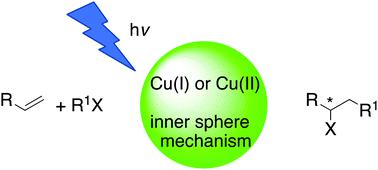当前位置:
X-MOL 学术
›
Chem. Soc. Rev.
›
论文详情
Our official English website, www.x-mol.net, welcomes your feedback! (Note: you will need to create a separate account there.)
Copper-photocatalyzed ATRA reactions: concepts, applications, and opportunities
Chemical Society Reviews ( IF 46.2 ) Pub Date : 2022-06-15 , DOI: 10.1039/d2cs00303a Sebastian Engl 1 , Oliver Reiser 1
Chemical Society Reviews ( IF 46.2 ) Pub Date : 2022-06-15 , DOI: 10.1039/d2cs00303a Sebastian Engl 1 , Oliver Reiser 1
Affiliation

|
Atom transfer radical addition (ATRA) reactions are linchpin transformations in synthetic chemistry enabling the atom-economic difunctionalization of alkenes. Thereby a rich chemical space can be accessed through smart combinations of simple starting materials. Originally, these reactions required toxic and hazardous radical initiators or harsh thermal activation and thus, the recent resurgence and dramatic evolution of photocatalysis appeared as an attractive complement to catalyze such transformations in a mild and energy-efficient manner. Initially, this technique relied primarily on complexes of precious metals, such as ruthenium or iridium, to absorb the visible light. Hence, copper photocatalysis rapidly developed into a powerful alternative, not just from an economic point of view. Originally considered to be disadvantageous as a pathway for deactivation by quenching their excited state, the dynamic nature of Cu-complexes enables them to undergo facile ligand exchange and thus opens up special opportunities for transformations utilizing their inner-coordination sphere. Moreover, the ability of Cu(II), representing a persistent radical, to capture incipient radicals offers the possibility to access heretofore elusive two-component, but also three-component, ATRA reactions, not feasible with ruthenium or iridium catalysts. In this regard, the idea of using Cu(I)-substrate assemblies as active photocatalysts is an emerging field to achieve such 3-component coupling reactions even under enantioselective control, which is reflected by an increasing number of reports being covered in this review.
中文翻译:

铜光催化 ATRA 反应:概念、应用和机会
原子转移自由基加成 (ATRA) 反应是合成化学中的关键转化,能够实现烯烃的原子经济双官能化。因此,可以通过简单起始材料的智能组合访问丰富的化学空间。最初,这些反应需要有毒和有害的自由基引发剂或剧烈的热活化,因此,最近光催化的复兴和戏剧性发展似乎是一种有吸引力的补充,可以以温和和节能的方式催化这种转化。最初,这项技术主要依靠贵金属的络合物,如钌或铱,来吸收可见光。因此,铜光催化迅速发展成为一种强大的替代品,而不仅仅是从经济角度来看。最初被认为是通过淬灭其激发态来失活的不利途径,Cu 配合物的动态特性使它们能够进行轻松的配体交换,从而为利用它们的内配位球进行转化开辟了特殊的机会。此外,Cu(II ),代表持久自由基,以捕获初始自由基提供了获得迄今为止难以捉摸的双组分以及三组分ATRA反应的可能性,这对于钌或铱催化剂是不可行的。在这方面,使用 Cu( I )-基材组件作为活性光催化剂的想法是一个新兴领域,即使在对映选择性控制下也能实现这种三组分偶联反应,这一点反映在本综述中越来越多的报道中。
更新日期:2022-06-15
中文翻译:

铜光催化 ATRA 反应:概念、应用和机会
原子转移自由基加成 (ATRA) 反应是合成化学中的关键转化,能够实现烯烃的原子经济双官能化。因此,可以通过简单起始材料的智能组合访问丰富的化学空间。最初,这些反应需要有毒和有害的自由基引发剂或剧烈的热活化,因此,最近光催化的复兴和戏剧性发展似乎是一种有吸引力的补充,可以以温和和节能的方式催化这种转化。最初,这项技术主要依靠贵金属的络合物,如钌或铱,来吸收可见光。因此,铜光催化迅速发展成为一种强大的替代品,而不仅仅是从经济角度来看。最初被认为是通过淬灭其激发态来失活的不利途径,Cu 配合物的动态特性使它们能够进行轻松的配体交换,从而为利用它们的内配位球进行转化开辟了特殊的机会。此外,Cu(II ),代表持久自由基,以捕获初始自由基提供了获得迄今为止难以捉摸的双组分以及三组分ATRA反应的可能性,这对于钌或铱催化剂是不可行的。在这方面,使用 Cu( I )-基材组件作为活性光催化剂的想法是一个新兴领域,即使在对映选择性控制下也能实现这种三组分偶联反应,这一点反映在本综述中越来越多的报道中。


























 京公网安备 11010802027423号
京公网安备 11010802027423号